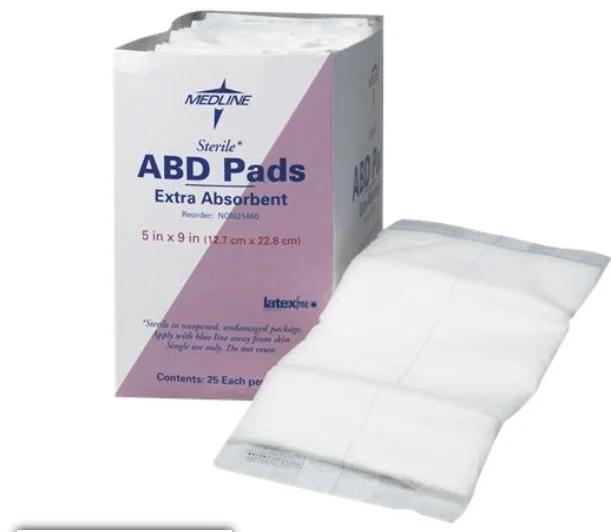
Wound care requires tailored dressing and management according to the patient's specific needs. A suitable sauce shortens the healing and recovery day after an injury or surgery. Abdominal pads are one of the several dressings used for large wounds with heavy drainage. Healthcare professionals must assess the impairment and determine the type of dressing required. That is why a simple dressing with little absorbent capacity sometimes does not work. In this situation, it is crucial to consider the one which fulfills the need for heavy exudate absorption.
What Are Abdominal Pads or absorbent Pads?
Abdominal or ABD pads are not only associated with abdominal wounds. However, the places are considered the best choice for large damages as it drains heavy exudate, whether the injury is on the abdomen or any other body part.
It is a non-woven dressing with a thick layer of cellulose that not only absorbs the fluid but also disperses it—the process is one thorough sealing off the affected site area. To avoid any leakage, the back of the pad comprises a hydrophobic layer with sealed edges.
what are the Types of ABD Pads available in the market
The pads are available in the market in sterile and non-sterile versions. These affect the injured site and commence the healing process in various applications. The pads can be used with antibiotic ointment to enhance the healing and avoid infection.
- Sterile Abdominal pads
- Non-sterile abdominal pads
how does an abdominal Pad work
The abdominal pads absorb the fluid into a thick inner part of the dressing. It keeps the wound dry, seals off the affected site, and helps protect it from infection and oozing.
Abdominal pads are used in two ways. For moderate exudate, a dressing contacts the primary wound. When it comes to the injury with heavy fluid discharge, a secondary dressing applies to the primary one. Here primary dressing could be a transparent film dressing or alginate wound dressing. Medical tapes can place the secondary dressing in the right position.
Moisture facilitates the healing of a large wound along with scrapes. Abdominal pads create the best possible healing environment for the injury by retaining moisture. This helps prevent external contaminants from coming in contact with the wound while perfectly sealing the fluid inside it. This allows the healing to be done quickly and safely without any chance of harm from external pollutants.
How to Apply Abdominal Pads the correct way?
The abdominal pad can be folded to take the shape of the wound. First, place the pad on the wound or incision. Ensure that the white side faces the wound, not the one with the stripe. Cover the bandage with tape or another bandage with pressure. This will help slow down the release of the fluid. Change the abdominal and chest dressing one to two times a day.
If the drainage becomes slow or completely stops, apply regular dressing without any pressure.
Key Features of Abdominal Wound Dressing
Healthcare professionals recommend abdominal pads for the best features it offers. Following are a few characteristics of the pads which make it a suitable dressing for large wounds.
- For large trauma sites and the wounds of major surgeries.

- Non-woven and soft layer that comes in contact with the wound surface.
- Pads with different exudate levels are available that range from moderate to heavy exudate.
- Sealed edges to prevent leakages
- Highly absorbent cellulose layer to absorb and lock heavy exudate.
- Prevent whitening of skin (skin maceration)
- Padding for cushioning and pressure points
- Need for less frequent dressing changes
How to Consider the Best Abdominal Pad
Choosing the right abdominal pad is crucial to attaining healing quickly. For this, understanding of the type and severity of the wound cannot be overlooked. Below given are the aspects to consider.
Difference between the Types of DischargeApparently, all the discharge fluids from the wounds look similar, but there is a subtle difference between them. A fluid having cellular debris, cells, and proteins is known as exudate, while the one that is relatively clear with no cells and proteins is known as transudate. Exudate is generally produced due to inflammation, while the production of transudate causes by the change in hydrostatic pressure that causes inflammation.
The above-defined fluids do not depend on the type of wound a patient has or any ailment or injury that causes it. But these terms are used concerning pleural effusion. An important point to remember is whether the fluid is transudate or exudate, it needs to be safely removed from the wound sterilely.
Maximum capacity to absorb the fluid is necessary even if the discharge is heavy. For this purpose, the abdominal and chest dressing with all four edges is required to prevent leakage, even the minor ones.
Foreign particles or bacteria could become a significant issue for the complete healing of the wound. Germs and bacteria increase the chances of bacterial infection, ultimately halting the healing process and worsening the situation.
The preferred choice is to choose the abdominal pad that provides maximum absorbency based on the discharge fluid and protects the wound from microorganisms.
- Level of discharge fluid
It might be that all sterile abdominal pad types can be suitable for every wound, but it's not. Based on the type of wound, a patient might need a pad with either moderate of heavy absorbency. For those with heavy discharge, a pad with waterproof layering to prevent leakage will work. It makes the pads comfortable for the wearer and provides greater peace of mind.
Several abdominal pads have cellulose, providing extra cushioning and moisture to the wound. It permits transudate or exudate to spread throughout the pad.
These pads are for large wounds, incisions, and surgical wounds. A patient needs the correct pad size and wraps it with external support. An abdominal pad can be used as a secondary dressing to cover the wounds with heavy discharge.